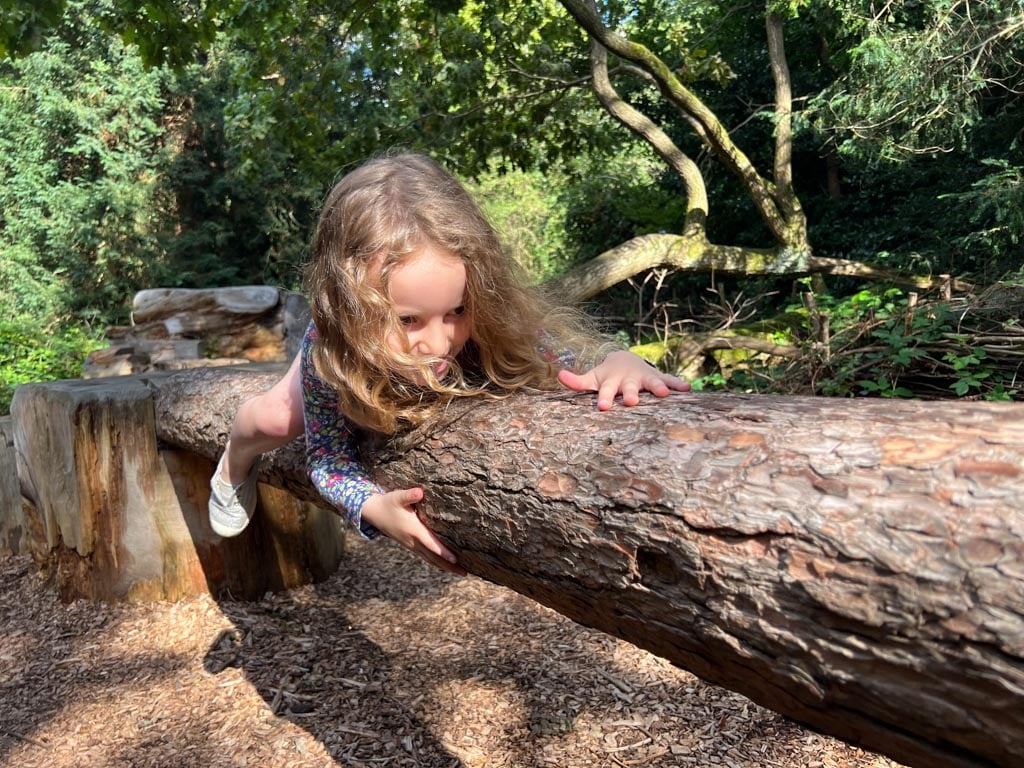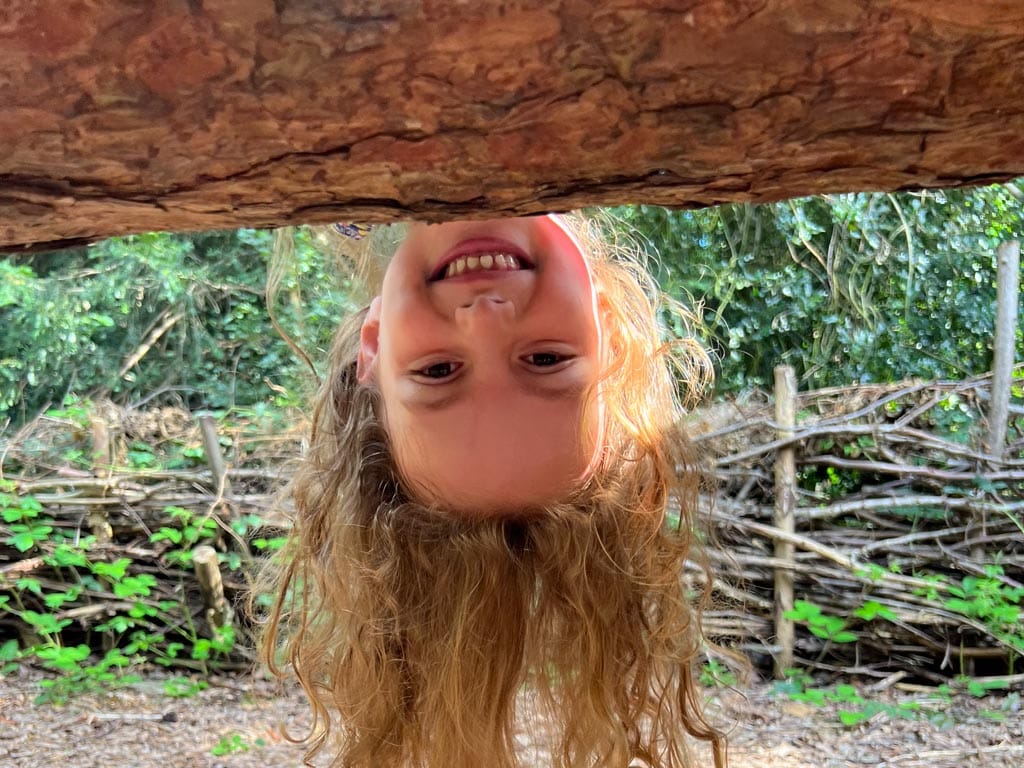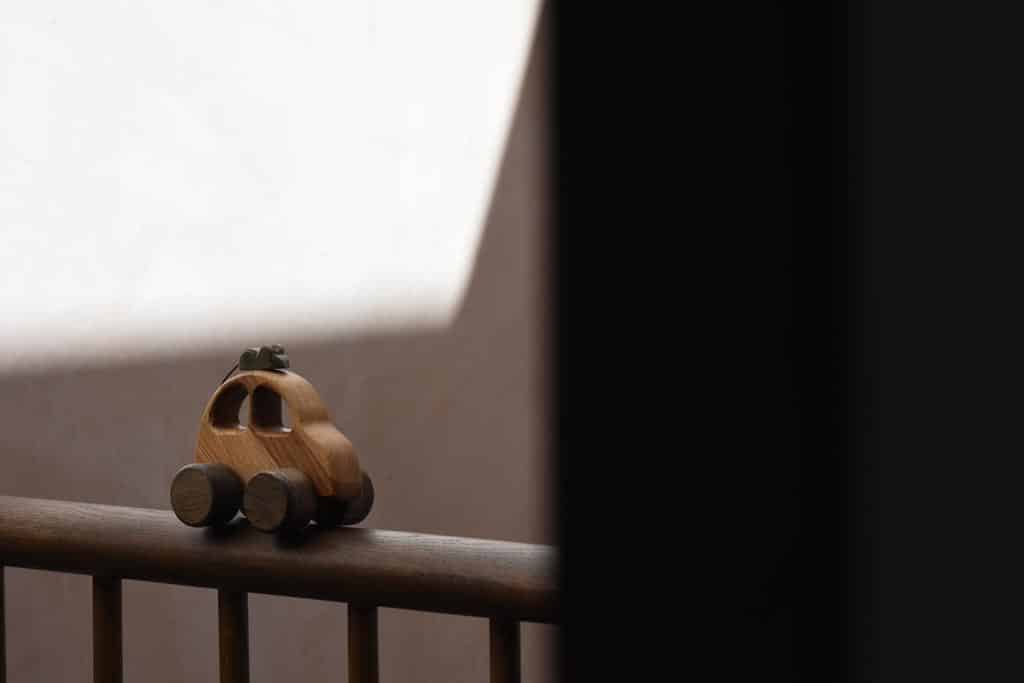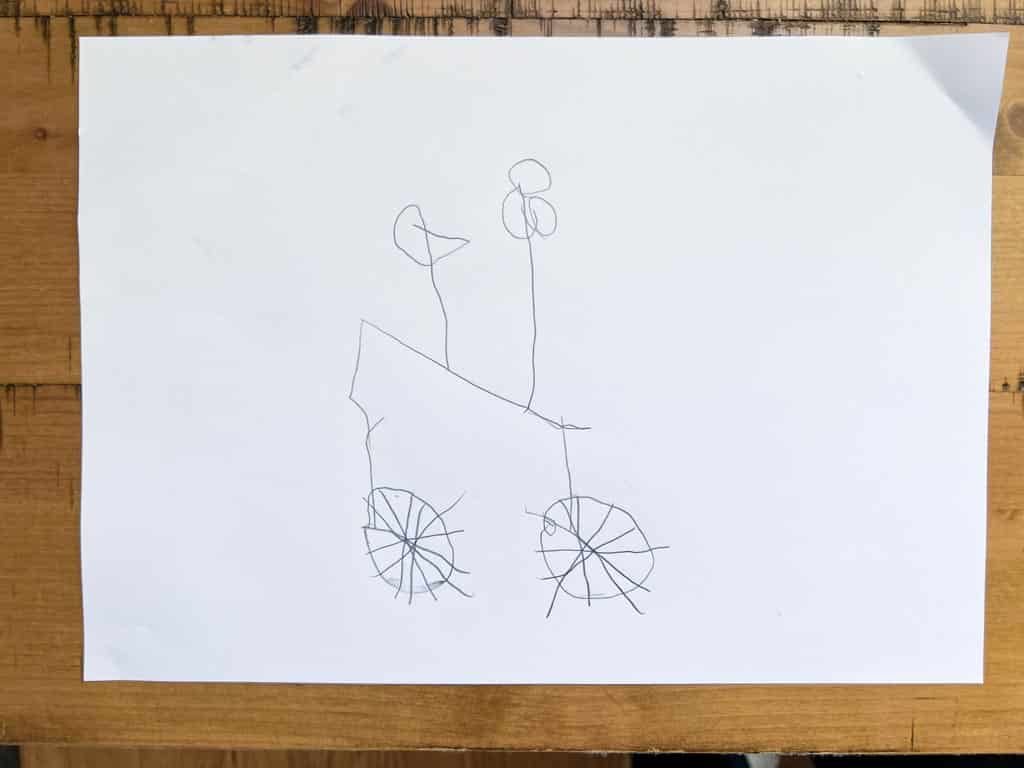Lie on the floor.
Yes, down there.
Do it now. Lie down on your tummy.
All the way down, with your chin on the ground.
What does the world look like from there?
Now take a toy – a plastic figure or a car. Move it around in front of you. It feels like you’re really in the scene, doesn’t it? You’re there with the car. You can see the world from its perspective.
You are exploring the orientation schema.
Do you remember doing this as a child, getting down on your toys’ level? It seemed so natural. It felt like the right way to play.
And how many hours did you spend lying on your back, looking up at the ceiling, or under a table, looking up at its underside?
I remember taking my toy soldiers and setting up scenes under the table, with figures on chair seats and the legs’ cross beams. I was right there in the action.

The orientation schema is about taking different perspectives.
How do things look from up there?
If I lie flat, I think I can fit through.
Daddy looks funny when I turn upside down!
What is a schema?
A schema is a mental model of how something works. Your orientation schema is how your brain represents ideas like postion, direction and perspective. Is your understanding correct? The only way to find out is to play, to test your model.
Here are some things to try with your child.
Orientation schema activities
- Walking on walls. Why do all children love walking on walls? To see the world from a different perspective. It’s a great balance challenge too.
- Stairs and ladders. How does the view change as you go up and down?
- Playground. Monkey bars, slides (try backwards and sideways), climbing frames, tunnels, roundabouts and see-saws. It’s orientation heaven.
- Look through your legs. It’s confusing!
- Handstands, headstands, cartwheels. A fantastic gross motor workout and a brilliant challenge to set yourself over the summer holidays. Can I go back to school able to do a cartwheel?
- Hills. Like Jack and Jill, go up the hill and roly poly back down again.
- ’Driving’ vehicles and trolleys. Take your pedal car or tricycle for a spin. Will you fit round that tight corner? Have you got enough room to turn. Pushing trolleys and buggies in the same way. Also great for spatial reasoning.
- Crates, planks and boards. Visit any preschool and you will see extra-large construction materials. Hollow blocks, crates and planks big enough to stand on. There are also often wooden climbing frames to attach the planks to. Children can create walkways and towers of their own. If you have the space, you can create something similar in your garden with just a plank or two and some sturdy crates. If you take one idea from this article, it’s this one. It offer by far the most play potential. This kind of building can keep children busy for an entire summer. If you don’t have a garden – or the right materials – you can make an approximation of it in your living room if you’re happy to push the sofa, coffee table and chairs together. It gets noisy but it’s brilliant fun. Add some wooden swords and defend your castle!
- Soft play. Packed full of orientation schema challenges.
- Ropes. Tough but rewarding work.
- Small world play. Get down on the level of your cars and figures. How do things look from their perspective? Watch them go into buildings, through tunnels – and back out again.
- Sit on an adult’s shoulders. Just don’t pull Daddy’s hair. It’s getting thin without your help! 🙁
- Climbing. Rocks and trees.
- Wheel-barrows. Hold your partner’s legs as they walk with their hands. Or simply crawl on all fours.
What are the best toys for the orientation schema?
You don’t have to buy anything. Any that you don’t already have at home can be approximated with a bit of imagination.
- Mirrors: Small handheld mirrors, wall-mounted mirrors, or even mirrored toys can be fascinating for children to explore reflections and see things from different angles. Especially interesting are four-way mirrors, great for positioning and symmetry games. And google ‘triangular floor mirror’ if you want to see how preschools do it.
- Building Blocks: Blocks allow children to build structures in various orientations – upright, sideways, and upside down. Magnetic building sets can add an extra layer of orientation exploration.
- Tunnel. These allow children to crawl inside, on top, or around, providing different spatial and orientation experiences.
- Balance boards. Feel the subtle change in orientation as you rock from side to side or backwards and forwards. Try rocking whilst crouched in a ball or on your back. How does it feel different? Read more about balance boards. Make your own by balancing a board on a pebble.
- Rocking horse. Of course.
- Ramps, marble runs, toy garages. Balls and cars roll down ramps and tracks. Cars are raised back up to the top level of the garage via a lift (elevator).
- Puzzles. Especially 3D puzzles, like the one above, but even simple 2-D cardboard puzzles demand a keen eye. Here is a fragment of a picture. Which way round does it go? Is that a bit of an arm – or a leg?
- Rotating music boxes or carousel toys. Watch as the ballerina twirls or wait to see the carousel horse come back into view.
- Toy cameras or periscopes. The world looks different through a lens – or a cardboard tube telescope
- Shadow puppets. How does the shadow deform as you change the puppet’s orientation?
Links to other schemas
Orientation is closely related to positioning and rotation. When you are looking at the world from a different perspective, hanging upside down or going through a tunnel or down a slide, it’s inevitable that you will change position and turn as you go.
Final word
Young children love to move and outdoor play is vital. But it’s not just about running around and letting off steam. Children need the chance to move their bodies in interesting and unusual ways. You don’t need fancy climbing frames and equipment. A plank, a tree, a headstand, some imagination. In short, offer the chance to explore the orientation schema.
That’s what’s so depressing about many school playgrounds – a concrete rectangle with nothing to do apart from run and play ball games. Fun, but limited fun. And the exercise is limited, too. Not enough upper body work, not enough balance.
Play can be so much more.
Read more: Schemas | Positioning schema | Rotation schema | Games with rules | Balance boards | Guide to puzzles
Further reading
- Athey, C. (2007). Extending thought in young children : a parent-teacher partnership. 2nd ed. London: Chapman.
- Arnold, C. (2022). Schemas in the Early Years. Routledge.
- Atherton, F. and Nutbrown, C. (2013). Understanding schemas and young children : from birth to three. London: Sage.
- Katey Mairs, Arnold, C. and Al, E. (2013). Young children learning through schemas : deepening the dialogue about learning in the home and in the nursery. London: Routledge.
- Louis, S. (2013). Understanding schemas in young children : Again! Again! London: Bloomsbury Publishing.




